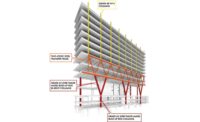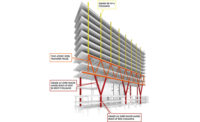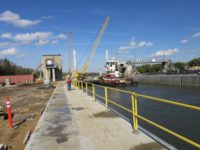ArcelorMittal, the world’s largest steelmaker, recently introduced a program to offer certificates to customers that certify they have reduced their carbon footprint through the steelmaker’s own greenhouse-gas emission reductions. It’s the first such carbon-offset program by a major steelmaker. While it is focused on the Luxembourg-based company’s European customers, the certificates could be used by North American contractors and owners, as Canada already has a carbon tax and some U.S. entities require reporting.
The program, XCarb green steel certificates, allows buyers to purchase vouchers along with steel orders that can show an offset of Scope 3 carbon dioxide and other greenhouse gas emissions. Scope 3 emissions can come from anything in a company’s value chain, such as steel used in buildings, according to the GHG Protocol used by many governments to report emissions worldwide. The “green steel” will be produced by ArcelorMittal’s plants in Europe that use technologies such as hydrogen direct-reduced iron or electric-arc furnaces (EAFs), which use electricity that can be certified as coming from renewable sources such as wind turbines, to produce steel. Producing coking coal through biomass and capturing emissions for use in chemical production also will be used to certify the green steel.
"As a company we've applied for (Europen Union Green Deal) funding to support some of the more capital intensive projects that we want to go ahead with in France and in Germany and other places," says Sophie Evans, head of communications for ArcelorMittal Europe. "So, there is already support in the pipeline from the EU and we're already working with others, at a local level, in places such as Hamburg, with the city authorities there, who are supporting us by building the hydrogen networks that we'll need."
Along with a certified recycled-steel program, the certificates are part of an overall strategy that ArcelorMittal hopes will allow it to reduce its emissions to zero by 2050 as part of the Paris Climate Accord. Olivier Vassart, CEO of ArcelorMittal's Steligence division which focuses on construction science, said that no one steel mill will create the products certified in the program.
"The amount of certificates which are available will be aligned through the global progress we achieve in each of the individual mills," he explained. "The physical steel that arrives at your door could come from Dunkirk in France. It could come from Spain, it could come from Germany. That's why we're operating at a Europe-wide level because that's the way the whole company operates."
The green and recycled-steel product lines will comprise only 2% of ArcelorMittal’s total annual steel production by the end of 2022—roughly 600,000 metric tons—but ArcelorMittal plans to expand production to a target of 10% of its total steel products by 2025-30.
ArcelorMittal CEO Satiya Mittal said in October the company is applying for European Trading Scheme innovation funds for projects that could help reach its goal of decarbonization by 2050. Evans said ETS funds as well as other sources would fund the company's various technology projects meant to achieve that goal.
“It’s a challenging commitment,” says Kate Simonen, executive director of the Carbon Leadership Forum and professor and chair of the department of architecture at the University of Washington. “That’s why it’s hard to imagine all of the industries being able to decarbonize, but there are road maps and pathways within each sector that are getting there.
“Leading global companies are developing frameworks by which they are setting a pathway to at least move toward that direction and invest in that,” Simonen adds.
She points to states such as California, which has made purchasing departments for all state projects report a carbon footprint as a possible use of the green certificates by U.S. steel buyers.
"We need to look at the legal framework in the different regions of the world," Vassart says, "but, for the moment, the system has been tailor-made for European regulation. It is linked to how companies here are calculating their CO2 footprint."
The American Institute of Steel Construction, which represents structural steel fabricators, touted U.S. EAF steelmaking capacity when asked about ArcelorMittal’s initiative.
“The federal policies that would most effectively reduce emissions from steelmaking are robust Buy America provisions,” says Max Puchtel, AISC director of government relations and sustainability. “This is due to our ample supply of low-carbon energy sources, ample scrap supply and focus on EAF steelmaking.”
He also said that end users are looking for ways to demonstrate carbon reductions in their projects, whether by regulation or customer requirement.
The American Iron and Steel Institute, which represents U.S. steelmakers, did not address questions about compliance with government emissions mandates but also touted U.S. EAF capacity and the high percentage of low-emitting natural gas used in U.S. mills. AISI also says U.S. steelmakers are doing their own research to produce the technology that can eventually produce decarbonized steel.
“Work is underway on innovations for increased use of renewable energy in steel production and advancements in domestic production using direct-
reduced iron and hot-briquetted iron, which use natural gas as a reductant, in place of pig iron in both integrated and EAF steelmaking," says Kevin Dempsey, AISI president and CEO.
Vassart, says that while the path to eventual decarbonization still has significant hurdles for ArcelorMittal to clear, public policy mandates and innovation from companies such as his can help reach the 2050 finish line.
"We know the road ahead is not straightforward," he says. "With cross-sector collaboration and supporting public policy like we have to scale up the technology and ensure the largest-scale deployment of clean energy infrastructure, we know that we can transition to carbon-neutral steelmaking and play a really big role in helping Europe to achieve its climate ambition."






Post a comment to this article
Report Abusive Comment